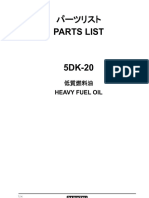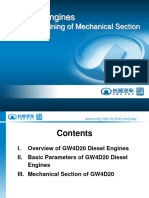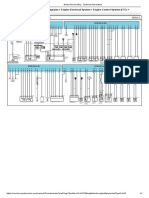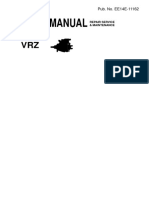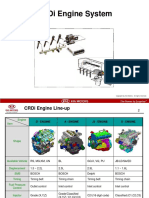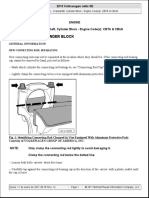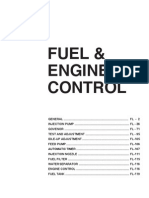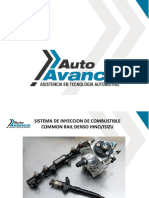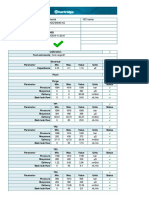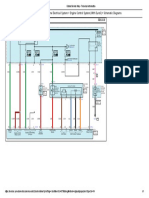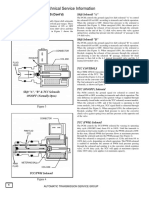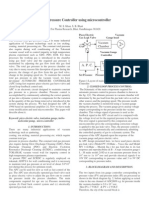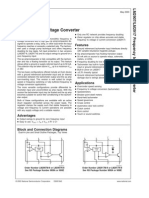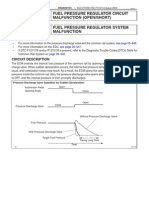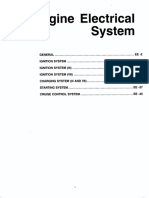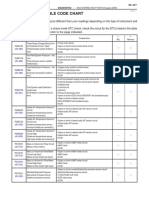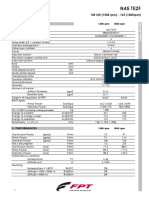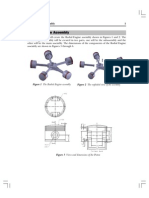Bomba Terracan Electronica
Bomba Terracan Electronica
Uploaded by
Jenny Mora LeonCopyright:
Available Formats
Bomba Terracan Electronica
Bomba Terracan Electronica
Uploaded by
Jenny Mora LeonCopyright
Available Formats
Share this document
Did you find this document useful?
Is this content inappropriate?
Copyright:
Available Formats
Bomba Terracan Electronica
Bomba Terracan Electronica
Uploaded by
Jenny Mora LeonCopyright:
Available Formats
1
TERRACAN
D4BH (2.5 TCI) Diesel Engine
Fuel System (COVEC-F)
Engine Specification
ITEMS
DISPLACEMENT(cc)
BORE STROKE(mm)
FIRING ORDER
2.5 T/C
2476
91.1 95
1-3-4-2
COMPRESSION RATIO
21
INJECTION TIMING( )
CAM Lift 10.03mm
INJECTION TYPE
NUMBER OF CYLINDER
IDLE RPM
PREHEATING DEVICE
INTAKE SYSTEM
INDIRECTION
4
750
GLOW PLUG
TURBO
Outline
Electronic fuel injection pump (Covec-F) has the same fuel intake and
compression system as mechanical injection pump has.
However, it uses an electronic governor(GE Actuator) instead of a fly-weight
and uses control unit cable instead of a control lever. In checking engine cycle,
mechanical pump uses gear of fly weight holder, but electronic pump uses
sensing gear plate with 4 projections, installed on the driveshaft. A timing
control valve(TCV), which adjust pressure to moot optimal injection timing,
installed between high and low pressure chambers of the timer at lower part of
the main pump body, in mechanical injection pumps, check valves are installed
in part of the inside of the overflow valves. In electronic injection pumps,
however, check valve are installed at all valves, enabling to hold over-flows
until the pressure is stabilized. A timer position sensor(TPS), which senses
location of timer piston is also installed in electric injection.
GE Actuator
Fuel Cut Sol.
Np Sensor
Timer Control Valve.
ECM Input/ Output
GE(Governor Electric) Actuator
GE actuator is attached to the governor chamber at the upper part of the
injection pump. Governor chamber and pump chamber are connected with a
magnetic filter in between. Coil is cooled by the fuel coming into the governor
chamber. A magnetic filter prevents foreign material(ferrous ingredients) from
entering the chambers. Eccentric ball pin that are inserted into control sleeve
holes are placed at the end of the shaft forced into the rotor.
The electronic governor actuator is a magnetic field type. Once the coil
receives electric current, it generates a magnetic field and rotates the rotor until
it reaches the designated range.
The strength of magnetic field at coil is proportional to the strength of input
current and rotates the rotor to the relative position of the return spring ,
enabling the control sleeve to make linear movements.
ECM Input/ Output
GE (Governor Electric) Actuator
F.I.P
Connector
No.10 GE-
Specification
No.6 GE+
No.6 ~ No.10: 0.6
Connection with ECM
No.6
ECM Pin No. 1, 14
No.10
ECM Pin No. 2, 15
Waveform
ECM Pin No. 1, 14
ECM Pin No. 2, 15
ECM Input/ Output
TCV (Timing Control Valve)
The TCV is located at the lower part of the injection pump. Two holes ( A and
B ) in the pump housing connect to the TCV. Hole A connects the timer piston's
high pressure chamber to the fuel inlet side of the TCV. A filter is installed at
this inlet to exclude foreign mater Hole B connects the timer piston's low
pressure chamber to the outlet at the tip of he TCV.
Installed between the timer piston's high and low pressure chambers, the TCV
adjusts high pressure chamber pressure by opening and closing the needle.
When current is not flowing to the TCV, the tip of the needle completely
separates the high and low pressure chambers. Then current is supplied,
needle tip seat is opened, the high and low pressure chamber are connected,
and the high pressure chamber pressure decreases. The timer piston is then
moved by timer spring to a piston that balances the high pressure chamber
pressure. Accompanying this roller holder rotates to vary the injection timing.
Injection timing can therefore be varied by utilizing the ON-OFF duty ratio of
the current flowing to the TCV. Injection timing is controlled by duty. All
characteristics and TCV drive signal duty ratios. Also, he frequency of the TCV
drive signal can be varied to correspond to the frequency of injection pump
speed.
Duty ratio is the ratio the time that the timing control valve is closed per unit of
time (i. e. per cycle).
Duty ratio = to / T x 100 (%)
Injection timing is related when the duty ratio decreases from 100%.
When electric current flows at Timing Control Valve, the needle is pulled lift by
magnet, and seat part of the hall is opened. TCV is located between high
pressure and low pressure chambers and adjusts pressure by opening and
closing of the needle.
ECM Input/ Output
TCV (Timer Control Valve)
ECM Input/ Output
TCV (Timer Control Valve)
F.I.P
Connector
No.9 TCV-
Specification
No.5 TCV+
TCV
No.5 ~ No.9: 111.1
Connection with Others
No.5
IG. Key(B+)
No.9
ECM Pin No. 13
Waveform
At idle
At acceleration
ECM Input/ Output
TPS (Timer Position Sensor)
TPS is attached on the low-pressure side of the timer and is consisted of core
rod and bobbin. It checks position of the timer piston electrically. TPS checks
inductance changes with the core rod and measures position of the timer
piston.
TPS
Connector
TPS
ECM Input/ Output
10
TPS (Timer Position Sensor)
No.1 TPS -
F.I.P
Connector
No.2 TPS +
No.3 TPS
MDL
Specification
No.2 ~ No.3, No.1 ~ No.3: 822
TCV
Connection with Others
No.1
ECM Pin No. 53
No.2
ECM Pin No. 46
No.3
ECM Pin No. 52
Waveform
ECM Pin No. 52, 46 at idle
ECM Pin No. 52, 53 at idle
ECM Input/ Output
Np (Pump Speed) Sensor
NP Sensor checks pump rpm and relays signal to PCM. NP sensor is
consisted of permanent magnets, steel core and coils. It detects electric
voltage generated by the changes in the machine going through the sensing
gear, through rotation signal.
When the 4 projections of the sensing gear plate go through the magnetic field,
while the drive-shaft is rotating, alternating current is generated, which is then
changed into a pulse signal and used as a rotation signal.
Np Sensor
11
ECM Input/ Output
12
Np (Pump Speed) Sensor
No.1 Shield GND
F.I.P
Connector
No.2
ECM GND
No.3
Specification
Signal
No.2 ~ No.3: 1.020.16k
Connection with Others
No.1
Wiring harness Shield GND
No.2
ECM Pin No. 38 GND
No.3
ECM Pin No. 30 Signal
Waveform
Np Signal at idle
Np Signal with CKP Sensor at idle
ECM Input/ Output
13
Q Compensation Resistance
Q Compensation Resistance is to prevent the different injection amount due to
the different characteristic resistance of fuel injection pump affecting to
injection amount controlled by ECM.
The resistance of Q Compensation is decided by below table. The
compensation resistance number is related to the resistance measured
between terminal D & G.
Q Adjustment
Resistance
Q Comp.
Measured
Number
Resistance
Resistance
No.1
No.2
No.3
No.4
No.5
No.6
No.7
No.8
No.9
No.10
No.11
No.12
No.13
945
946
947
948
949
950
951
952
953
954
955
956
957
0.18(k)
0.3(k)
0.43(k)
0.62(k)
0.82(k)
1.1(k)
1.15(k)
2(k)
2.7(k)
3.9(k)
5.6(k)
8.2(k)
15(k)
F.I.P
Connector
No.2
No.3
ECM Input/ Output
CSP (Control Sleeve Position) Sensor
The control Sleeve Position Sensor(CSP) at upper part of GE actuator detects
the position of control sleeve and feeds it back to ECU.
The fixed plate compensates changes of inductance caused by temperature.
The CSP sensor calculates the difference of the inductance at the two sensor
coils(upper and lower sensor coils) into angles and feeds them back to ECU,
and ECU compares its target angle with the actual one, if there is a difference
between the two angles, the ECU adjusts electric currents until the actual angle
equals the target angle.
14
ECM Input/ Output
15
CSP (Control Sleeve Position) Sensor
F.I.P
Connector
No.8 CSP
MDL
No.12 CSP -
Specification
No.4 CDP +
No.4 ~ No.8, No.12 ~ No. 8: 5.8k
Connection with ECM
No.4
ECM Pin No. 43, 49
No.8
ECM Pin No. 44, 50
No.12
ECM Pin No.45, 51
Waveform
ECM Pin No. 43, 44 at idle
ECM Pin No. 43, 45 at idle
ECM Input/ Output
TF (Temperature Fuel) Sensor
This sensor detects the temperature of fuel.
If TF Sensor value is beyond 0.1V~4.6V for 5 second, ECM regards TF Sensor
as failed and sets fuel temperature to 50
F.I.P
Connector
No.7 Signal
No.11 GND
Specification
No.7 ~ No.11: 20.1k at 25
Connection with ECM
No.7
ECM Pin No. 18
No.11
Wiring harness GND
Waveform
ECM Pin No. 18 at
normal operating
Temperature
16
ECM Input/ Output
17
WTS (Water Temperature Sensor) Sensor
If Sensor value is beyond 0.1V~4.6V for 5 second, ECM regards WTS Sensor
as failed and sets coolant temperature from TF Sensor at starting. When TF
Sensor is failed, sets the temperature to 20.
Specification
Temp.() Resistance(k) Voltage(V)
-20
16
4.3
0
5.9
3.4
20
2.5
2.4
40
1.2
1.5
60
0.6
0.9
80
0.3
0.5
100
0.2
0.3
Connection with ECM
No.2
ECM Pin No. 17
No.1
Wiring harness GND
Waveform
ECM Pin No. 17 at
normal operating
Temperature
ECM Input/ Output
18
BPS (Booster Pressure Sensor) / TA (Intake-Air-Temperature)
Sensor
These two sensors are integrated into one. Located after the intercooler. BPS
detects the intake air pressure and TA sensor detects the temperature of intake
air.
If BPS value is beyond 0.2V~4.8V for 1. second, ECM regards BPS as failed and
fixes boost pressure to 760mmHg and prohibits EGR operation.
If TA sensor value is beyond 0.1V~4.6V for 5 second, ECM regards TA Sensor as
failed and fixes air temperature to 60.
No.2 TA Sig. No.1 GND
TA Sensor Specification
Temp.() Resistance(k) Voltage(V)
-20
16
4.3
0
5.9
3.4
20
2.5
2.4
40
1.2
1.5
60
0.6
0.9
80
0.3
0.5
100
0.2
0.3
No.4 BPS Sig.
No.3 Ref. Voltage 5V
Connection with ECM
No.1
ECM Pin No. 41 GND
No.2
ECM Pin No. 19 TA Signal
No.3
ECM Pin No. 33 Reference Voltage 5V
No.4
ECM Pin No. 34 BPS Signal
ECM Input/ Output
19
BPS (Booster Pressure Sensor) / TA (Intake-Air-Temperature
Sensor
Waveform
ECM Pin No. 34
BPS Signal at idle
ECM Pin No. 34 BPS
Signal at acceleration
from idle to 4200rpm
ECM Pin No. 34 BPS
Signal at 4200rpm
ECM Pin No. 19
TA Sensor Signal
ECM Input/ Output
APS (Accelerator Pedal Sensor)
This sensor detects the angle of accelerator pedal.
If sensor value is beyond 0.2V~4.93V for 1. second, ECM regards APS as
failed. If ECM detects APS malfunction, ECM fix accelerator opening to 0%
and prohibit EGR operation.
When only idle SW. is good, ECM can increase the accelerator opening to 30%
slowly. (equal to approx 1.5V)
In the event of complete failure, No throttle response
Connection with ECM
No.1
ECM Pin No. 32 V ref
No.2
ECM Pin No.40 APS Sig.
No.3
ECM Pin No.8 Idle SW Sig.
No.4
Wiring harness GND Idle SW. GND
No.5
ECM Pin No.39 GND
20
ECM Input/ Output
21
APS (Accelerator Pedal Sensor)
Idle Switch ON
ECM Pin No. 8 at acceleration
Good condition
Accelerator Pedal Sensor
ECM Pin No. 40 from idle to Max.
APS (Accelerator Pedal Sensor)
Good condition (Max. Throttle)
APS output signal failed, Idle Switch good, At Max. Throttle
ECM increases RPM slowly to 30% (4000rp)m
22
ECM Input/ Output
23
CPS (Crankshaft Position Sensor)
This sensor detects the position of crankshaft.
If there is no signal from sensor for 20 consecutive times of Np Sensor, ECM
regards CPS as failed and controls engine with Np (inj pump) Sensor signal.
Note: In this condition Twice ignition applies to start engine
DTC P0335 will be set
CPS
1mm
Connection with ECM
No.1
Shield GND
No.3
ECM Pin No.37 GND
Waveform
No.2
ECM Pin No.29 Signal
ECM Input/ Output
ECM Pin No. 29 at idle
24
CPS signal with Np signal at idle
ECM Input/ Output
25
FC (Fuel Cut) Valve
When the IG. Key is On, ECM supplies B+ Voltage to open fuel line.
When Immobilizer is on ECM inhibits the connection, (vale remains closed)
F.I.P
Connector
No.1 FC
Valve
FC Valve
Connection with ECM
No.1
ECM Pin No.26 Signal
Waveform
FC Valve signal at idle
Diagnosis Reference chart
26
(Checking Pump Components, Ignition off plug disconnected)
Terminal Component
Remarks
1
FCV
Fuel Cut Valve
2
Adj (-)
Adjustment resistor (-)
3
Adj (+)
Adjustment resistor (+)
4
CSP
Oscillate (+)
5
TCV (+) Timer Control Valve (+)
6
GE (+)
GE (+)
7
TF (+)
Fuel temperature (+)
8
CSP
MDL
9
TCV (-) Timer Control Valve (-)
10
GEGE (-)
11
TF (-)
Fuel Temperature (-)
12
CSP
Oscillate (-)
12
Note: Pin arrangement is different to H-1
Pumps are not interchangeable
Diagnosis Reference chart
27
(Checking Pump Components)
Component Plug (No of pins) Terminal
Resistance
Fuel Cut
12 pin black 1--Ground
7 ~ 9 Ohms
Actuator
12 pin black
6 ~ 10 0.71 0.13 Ohms
TCV
12 pin black
5~9
11 1.1 Ohms
TPS
3 pin black
2~3
82 2 Ohms
1 ~3
82 2 Ohms
Speed Sensor 3 pin grey
2 ~ 3 1.02 0.16 KOhms
Trim Resistor 12 pin black
3 ~2
same as resistor
CSP
3 pin
4~8
5.9 0.3 Ohms
8 ~ 12
5.9 0.3 Ohms
Fuel Temp
12 pin black
11 ~ 7
0.1 Kohms
Temp
23 +- 5
23 +- 5
23 +- 5
23 +- 5
23 +- 5
23 +- 5
23 +- 5
23 +- 5
23 +- 5
25
ECM Input/ Output
28
EGR (Emission Gas Re-circulation) Solenoid Valve
There are two EGR Solenoid Valves. One is controlled by duty signal from
ECM and connected from vacuum tank or atmosphere to the other EGR
Solenoid Valves. The other is controlled by On/Off signal from ECM and
connected to EGR Control valve.
EGR Vacuum Sol.
Valve Out port
EGR Sol. Valve
To EGR
Control Valve
From Vacuum
Pump
Atmosphere
Port
EGR Vacuum
Sol. Valve
Connection with ECM
EGR Vacuum Sol. Valve No.1
ECM Pin No.58 Signal
EGR Vacuum Sol. Valve No.2
Main Relay B+
EGR Sol. Valve No. 1
ECM Pin No.68 Signal
EGR Sol. Valve No. 2
Main Relay B+
ECM Input/ Output
29
EGR (Exhuast Gas Re-circulation) Solenoid Valve
Waveform
ECM Pin No. 58 at idle
ECM Pin No. 68 at acceleration
ECM Pin No.58 at acceleration
ECM Input/ Output
30
I/C (Inter Cooler) Fan Motor Relay
Terracan has a intercooler fan motor controlled by ECM. Intercooler fan motor
is operated when vehicle speed is under 60Km/h and intake air temperature is
over 58 and engine speed is over 550rpm.
Connection with ECM
I/C Fan Motor Relay No.85
ECM Pin No.35
Grow Plug Relay
ECM controls the glow plug to heat the intake air through glow plug relay.
According to the condition, the heating time is as below.
Preheating
Post heating
Coolant Temp. Heating time
2Sec.
60
8Sec.
-15
10Sec.
-20
15Sec.
-25
24.5Sec.
-40
Coolant Temp. Heating time
3Sec.
60
3Sec.
0
3Sec.
-10
5Sec.
-20
5Sec.
-40
Connection with ECM
Glow Plug Relay No.85
ECM Pin No.55
ECM Input/ Output
31
Others
Main relay control
ECM controls Main relay to provide the B+ voltage to actuators like EGR Sol.
Valves, Grow Plug and A/C fan relay etc.
Lamps
ECM controls Engine check lamp and Glow lamp
A/C Fan Motor Relay & A/C Comp. Relay
Connection with ECM
Main Relay No.85
ECM Pin No.73
Engine check lamp
ECM Pin No.62
Glow lamp
ECM Pin No.63
A/C Fan Motor Relay No.85
A/C Comp. Relay
ECM Pin No.59
ECM Pin No.72
ECM Controls
32
Q(Injection amount) Controls
Example)
CPS
Eng. speed
Np Sensor when CPS is failed
Pump speed
3,000 RPM
ECM
GE Actuator
Injection Quantity
Fuel Injection
37mg/stroke
2.8 Volt
APS
Accel. Position
CSP
50%
Feedback
Control Sleeve
Position Check
IT (Injection Timing) Controls
Np Sensor when CPS is failed
Pump speed
Eng. speed
CPS
ECM
TCV
Injection Timing
Duty(%) Control
TPS
ECM
Injection Quantity
Feedback
Injection
Timing Check
Basic Adjustments (Injection pump timing)
1. Engine stop
2. Turn the crankshaft to place in No.1 Cylinder at top dead center on
compression stroke
3. Loosen injection pipe
4. Loosen injection mounting bolts and nuts
5. Remove timing check plug from injection pump head
6. Attach the special tool and a dial gauge
7. Turn crankshaft to such a position that the notch on pulley is at
approximately 30 before top dead center. Then , set dial indicator to
zero.
33
Basic Adjustments (Injection pump timing)
8. Slightly turn crankshaft clockwise and counterclockwise to make sure
that dial indicator pointer does not deviate from zero position.
9. Turn the crankshaft in the normal direction and position the notch of
crankshaft pulley at 5 ATDC. (N/A : 5 T/C : 7 TCI : 7 )
10. If the dial indicator does not indicate the specified value.
Tilt the injection pump body to the right or left until the indicator does
indicate the standard value.
11. Tighten mounting bolt of injection bolts and nuts.
12. Remove special tool and dial gauge
13. Install timing check plug with new copper gasket
34
Basic Adjustments (Valve clearances)
1. Warm up temperature
2. Remove upper timing belt cover and rocker cover
3. Turn the crankshaft clockwise and align the timing mark on the
camshaft sprocket with the timing mark
4. Check the valve clearance indicated in the
diagram(A)
Standard clearance : 0.25mm(0.098in)
5. If not within the standard value, adjust the valve clearance with the
adjusting screw and the thickness gauge
6. Rotate clockwise the crankshaft one complete turn (360 )
7. Check the valve clearance indicated in the diagram(B)
Standard clearance : 0.25mm(0.098in)
35
HI-Scan
36
HI-Scan
37
See Page 39
Current Data
HI-Scan
Actuation Test
38
HI-Scan DTC List
39
No
DTC No
Conents
MIL
P0105
BAROMETRIC SENSOR - MAL
P0110
INT - AIR TEMP CIRCUIT - NAL
P0115
ENG COOLANT TEMP - MAL
P0120
ACCEL P. SENSOR - MAL
P0121
APS. RANGE / PERFORMANCE - MAL
P0180
FUEL TEMP. SENSOR - CIRCUIT-MAL
P0320
ENGINE SPEED INPUT CIRCUIT - MAL
P0335
CRANKSHAFT P. SENSOR - MAL
P0500
VEHICLE SPEED SENSOR - MAL
10
P0600
IMMOBILZER COMMUNICATION - MAL
11
P0605
CONTROL MODULE (EEPROM) - ROM MAL
12
P0613
ECU - MALFUNCTION
13
P1116
BOOST PRESSURE SENSOR - MAL
14
P1120
ELECTRIC GOVERNOR - MAL
15
P1122
BOOST PRESSURE CONTROL VALVE - MAL
16
P1123
TIMER POSITION SENSOR - MAL
17
P1127
CONTOL SLEEVE POSITION SENSOR - MAL
18
P1131
INJECTION QUANTITY ADJUST - MAL
19
P1135
INJECTION TIMING SERVO - MAL
20
P1324
GLOW RELAY - MALFUNCTION
21
P1522
BATTERY VOLTAGE ERROR
22
P1525
5V SOURCE VOLTAGE
23
P1621
FUEL CUT VALVE - MAL
You might also like
- L200 ECU (Pin-Out) Motores Familia 4N15Document1 pageL200 ECU (Pin-Out) Motores Familia 4N15Roberto Ortega Micalizzi100% (5)
- C6.6 - Electrical SchematicDocument2 pagesC6.6 - Electrical SchematicSamuel da Silva94% (31)
- Gearbox H41, H42, H50, H55F PDFDocument115 pagesGearbox H41, H42, H50, H55F PDFJenny Mora Leon100% (4)
- 5DK20 New ManualDocument329 pages5DK20 New ManualPradeep Nadar90% (31)
- YD25 Manual DieselDocument42 pagesYD25 Manual Dieselalexsandro91537100% (1)
- (TM) Great Wall Manual de Motor Great Wall gw4d20 2016 en InglesDocument61 pages(TM) Great Wall Manual de Motor Great Wall gw4d20 2016 en InglesKelvin van der MerweNo ratings yet
- D4BH EngineDocument51 pagesD4BH Enginevagpoul91% (32)
- Manual de Diag. JMC - N601Document226 pagesManual de Diag. JMC - N601maqfax100% (1)
- Hyundai HD78 Fuel SystemDocument485 pagesHyundai HD78 Fuel SystemBigfair HD7890% (30)
- Kia K2500 PDFDocument100 pagesKia K2500 PDFcamilo100% (8)
- (KIA) Manual de Taller Kia Rio 2001 PDFDocument69 pages(KIA) Manual de Taller Kia Rio 2001 PDFJenny Mora Leon100% (1)
- Great-Wall-Wingle-5 2016 en Manual de Taller 76a3f09b84 (394-510)Document117 pagesGreat-Wall-Wingle-5 2016 en Manual de Taller 76a3f09b84 (394-510)Brändön Länfräncö100% (3)
- TOYOTA i-ART Common Rail System PDFDocument12 pagesTOYOTA i-ART Common Rail System PDFpaulo valentini100% (2)
- Motor Hyundai D4eb-Diesel 2.2Document91 pagesMotor Hyundai D4eb-Diesel 2.2Igatech Diesel82% (11)
- EECD0001Document36 pagesEECD0001Sergey Gusev100% (3)
- Wartsila 8L32 Spare PartsDocument552 pagesWartsila 8L32 Spare PartsMick V90% (10)
- 4CHE3 Parts Catalog PDFDocument75 pages4CHE3 Parts Catalog PDFokta bedjo100% (1)
- Jac X200 PDFDocument92 pagesJac X200 PDFLuis Mauricio Ortiz Meza100% (1)
- G4S Inyector DensoDocument5 pagesG4S Inyector DensoAlberto Abarca100% (2)
- CAT Compression Brake Lash - AdjustDocument2 pagesCAT Compression Brake Lash - Adjustbenge henrique100% (2)
- 2016 H 100 D 2.5 Tci-A2-DiagramDocument1 page2016 H 100 D 2.5 Tci-A2-DiagramMAXIMILIANO CASTILLO ANTONIONo ratings yet
- 4m41 Pump160061130 Bomba VE VRZ EE14E 11162 VRZ Service ManualDocument117 pages4m41 Pump160061130 Bomba VE VRZ EE14E 11162 VRZ Service Manualesyjam86% (7)
- Hyundai HD78 Electric EquipmentDocument97 pagesHyundai HD78 Electric EquipmentBigfair HD78100% (9)
- 1KZ-TE 096500-0130 22100-67070 Shema+cat +testplanDocument9 pages1KZ-TE 096500-0130 22100-67070 Shema+cat +testplanAnonymous wpUyixsjNo ratings yet
- Enviando Denso Mitsubishi l200 Common RailDocument55 pagesEnviando Denso Mitsubishi l200 Common Railisrael machicado calle100% (4)
- Haima Engine-HM484 (HM484Q) ManualDocument88 pagesHaima Engine-HM484 (HM484Q) Manualmohhizbar100% (2)
- Denso Ecd-VDocument118 pagesDenso Ecd-VIongornistu100% (7)
- 2.CRDi Diagnosis Expert - KMCDocument82 pages2.CRDi Diagnosis Expert - KMCAhmad Nashrullah100% (5)
- Ec np300Document1,098 pagesEc np300Evander Leon Robles100% (3)
- 337156Document73 pages337156Anderson BombistaNo ratings yet
- (Ssangyong) Manual de Taller Ssangyong Actyon 2001Document28 pages(Ssangyong) Manual de Taller Ssangyong Actyon 2001serccons S.A.S100% (2)
- Renault ClioDocument2 pagesRenault ClioGeorgian Cranta100% (1)
- 95 Altima ECU PinoutDocument8 pages95 Altima ECU Pinoutjr100100100% (1)
- TFE 731 Chap 76Document42 pagesTFE 731 Chap 76Egor85100% (4)
- Continental Ram Automotive Product Catalogue 08-09-17Document164 pagesContinental Ram Automotive Product Catalogue 08-09-17Jenny Mora Leon100% (1)
- (TM) Volkswagen Manual de Taller Volkswagen Jetta Hybrid 2013 en InglesDocument124 pages(TM) Volkswagen Manual de Taller Volkswagen Jetta Hybrid 2013 en InglesJenny Mora LeonNo ratings yet
- Jetta SE 2.5L 2013Document119 pagesJetta SE 2.5L 2013Jenny Mora Leon100% (1)
- Subaru Justy PDFDocument112 pagesSubaru Justy PDFJenny Mora LeonNo ratings yet
- Hyundai Santa Fe 2000 Workshop Manual - Steering SystemDocument27 pagesHyundai Santa Fe 2000 Workshop Manual - Steering SystemJenny Mora LeonNo ratings yet
- (KIA) Manual de Taller Kia Rio 2003Document59 pages(KIA) Manual de Taller Kia Rio 2003Jenny Mora Leon100% (1)
- TOYOTA - Ficha de Calibración Bomba de Inyección - 1KZ - TDocument102 pagesTOYOTA - Ficha de Calibración Bomba de Inyección - 1KZ - TJuan Junior Asto Torres100% (1)
- Hyundai HD78 Fuel SystemDocument485 pagesHyundai HD78 Fuel Systemjuanburbano100% (1)
- Hyundai Mighty W Engine CrsDocument38 pagesHyundai Mighty W Engine CrsVictor Alfonso Russi AldanaNo ratings yet
- D4ALDocument119 pagesD4ALPablo Campos67% (6)
- Hyundai J3 PDFDocument203 pagesHyundai J3 PDFAlexey Kolmakov100% (4)
- Hyundai Common Rail DelphiDocument68 pagesHyundai Common Rail DelphiJATC75% (4)
- Jin Bei ManualDocument300 pagesJin Bei Manualrjan7pe100% (7)
- D4BH (2.5 TCI) Diesel Engine D4BH (2.5 TCI) Diesel Engine: ( (C CO OV VE EC C - F F) )Document51 pagesD4BH (2.5 TCI) Diesel Engine D4BH (2.5 TCI) Diesel Engine: ( (C CO OV VE EC C - F F) )Patricio ValenciaNo ratings yet
- 01 Dk4a EngineDocument131 pages01 Dk4a Enginevitor santos100% (1)
- Actyon FuelSystem D20DTRDocument24 pagesActyon FuelSystem D20DTRAnonymous 7t2BOJbNo ratings yet
- Curso Common Rail Denso MedellinDocument120 pagesCurso Common Rail Denso MedellinArbey Gonzalez100% (2)
- Hyundai h1 AjustesDocument22 pagesHyundai h1 AjustesJesús AraizaNo ratings yet
- SCORPIO VLX DIAGNOSTIC MANUAL mHAWK Rev1Document178 pagesSCORPIO VLX DIAGNOSTIC MANUAL mHAWK Rev1Marcelo Gutiérrez lopez100% (1)
- Denso - Ecd IIDocument26 pagesDenso - Ecd IIVASEK100% (7)
- Motor M209 HFC4DA1-2C Manual 1 Servicio Taller PDFDocument801 pagesMotor M209 HFC4DA1-2C Manual 1 Servicio Taller PDFLuis Jesus Perez Neto100% (7)
- Nissan VP 44 Pin DataDocument3 pagesNissan VP 44 Pin DataAlberto Abarca100% (3)
- Bk2q-9k546-Ag 20190701 112041 PDFDocument2 pagesBk2q-9k546-Ag 20190701 112041 PDFคุณชายธวัชชัย เจริญสุขNo ratings yet
- ECD-V4 OutlineDocument4 pagesECD-V4 OutlineВячеслав Глушак100% (2)
- Hyundai HD78 General Information - 1Document13 pagesHyundai HD78 General Information - 1Bigfair HD78100% (2)
- Códigos de Fallas Nissan Navara (Inglés)Document504 pagesCódigos de Fallas Nissan Navara (Inglés)Gonzalo Bermúdez50% (4)
- 2018 D 2.5 TCI-A2 Schematic Diagrams Engine Electrical System Engine Control System (With Euro6) Schematic DiagramsDocument1 page2018 D 2.5 TCI-A2 Schematic Diagrams Engine Electrical System Engine Control System (With Euro6) Schematic DiagramsANH LÊ100% (1)
- Ignition SystemDocument21 pagesIgnition System20145391studentNo ratings yet
- 27 Appendix D Technical Reference & SpecificationsDocument17 pages27 Appendix D Technical Reference & SpecificationspapipapiiNo ratings yet
- Technical Service Information3Document4 pagesTechnical Service Information3JoseNo ratings yet
- 26 Appendix C Data DefinitionsDocument14 pages26 Appendix C Data DefinitionspapipapiiNo ratings yet
- For Preparation DescriptionDocument6 pagesFor Preparation DescriptionRobert VojakNo ratings yet
- PVM1Document4 pagesPVM1silverfurNo ratings yet
- LM2907Document21 pagesLM2907leorio88No ratings yet
- Kenr6200 01Document2 pagesKenr6200 01Rodrigo Santibañez100% (1)
- M 05 0596Document10 pagesM 05 0596Jehuty88No ratings yet
- P.Kay ECU CodesDocument8 pagesP.Kay ECU Codesadgjl123456100% (1)
- Transmisión Automática Parte 2Document39 pagesTransmisión Automática Parte 2romeo_mec100% (1)
- Maintainence Schedule For Dmax: 5,000 MilesDocument5 pagesMaintainence Schedule For Dmax: 5,000 MilesJenny Mora LeonNo ratings yet
- Hyundai Santa Fe 2000 Workshop Manual - Engine Electrical SystemDocument49 pagesHyundai Santa Fe 2000 Workshop Manual - Engine Electrical SystemJenny Mora LeonNo ratings yet
- Hyundai Santa FE (2005-2007) Workshop Manual - Clutch SystemDocument12 pagesHyundai Santa FE (2005-2007) Workshop Manual - Clutch SystemJenny Mora LeonNo ratings yet
- Fuel System (G6EA - GSL 2.7) PDFDocument665 pagesFuel System (G6EA - GSL 2.7) PDFStefan AslamNo ratings yet
- Hyundai Santa Fe 2000 Workshop Manual - Transaxle, Transmission PDFDocument118 pagesHyundai Santa Fe 2000 Workshop Manual - Transaxle, Transmission PDFJenny Mora Leon100% (1)
- Hyundai Santa Fe 2000 Workshop Manual - Engine Mechanical System (V6 2.7)Document86 pagesHyundai Santa Fe 2000 Workshop Manual - Engine Mechanical System (V6 2.7)Jenny Mora LeonNo ratings yet
- Codigos Motor 1kdDocument5 pagesCodigos Motor 1kdJenny Mora LeonNo ratings yet
- Jeep Wrangler 2004 Repair ManualDocument2,436 pagesJeep Wrangler 2004 Repair Manualjesusgomguz100% (2)
- Catalogo KYB 2009Document94 pagesCatalogo KYB 2009Jenny Mora LeonNo ratings yet
- 6M33G825/5 Powerkit Engine Datasheet: RatingsDocument4 pages6M33G825/5 Powerkit Engine Datasheet: RatingsKarim Ahmed KhodjaNo ratings yet
- New Dealer Package Kit 2007 HarleyDocument9 pagesNew Dealer Package Kit 2007 HarleyCleveston MoraisNo ratings yet
- Honda FIT Specs 9-2024Document6 pagesHonda FIT Specs 9-2024dannyhpiturboNo ratings yet
- Wankle Exhausts and The Relevance of Two-Stroke Design: An Engine's Exhaust Port Can Be Thought of As A Sound GeneratorDocument11 pagesWankle Exhausts and The Relevance of Two-Stroke Design: An Engine's Exhaust Port Can Be Thought of As A Sound GeneratorAndré Matsumoto100% (2)
- Kyma Diesel AnalyzerDocument4 pagesKyma Diesel Analyzermatjaz5550% (1)
- DI13072M 441kWDocument2 pagesDI13072M 441kWTravis BrownNo ratings yet
- Discover 125ST & 100T SPCDocument78 pagesDiscover 125ST & 100T SPCIttoop and sons Automobile100% (1)
- Husqvarna K760 2013-01Document33 pagesHusqvarna K760 2013-01Bruno DenolleNo ratings yet
- Auto Ignition Systems Design and OperationDocument16 pagesAuto Ignition Systems Design and OperationAustin BruceNo ratings yet
- Bosch K-Jetronic WebDocument42 pagesBosch K-Jetronic WebWongstorn DamrongmaneeNo ratings yet
- Renault Technical Note 3419A Turbocharger DiagnosisDocument15 pagesRenault Technical Note 3419A Turbocharger DiagnosisClaudiu CondreaNo ratings yet
- Engine Performance Data at 1500 RPM: A1.4 1 Cummins IncDocument4 pagesEngine Performance Data at 1500 RPM: A1.4 1 Cummins IncAkiki CharbelNo ratings yet
- Liqui MolyDocument144 pagesLiqui MolyKhurram NaseemNo ratings yet
- Torque Bolt Main Bearing Engine GS1141 CATDocument3 pagesTorque Bolt Main Bearing Engine GS1141 CATM WahyudiNo ratings yet
- Gas Engine GoverningDocument8 pagesGas Engine GoverningMiguel SoteloNo ratings yet
- N45 TE2F: 1/ GeneralDocument3 pagesN45 TE2F: 1/ General林哲弘No ratings yet
- 538 12Document4 pages538 12RuthAnayaNo ratings yet
- Radial Engine Assembly PDFDocument3 pagesRadial Engine Assembly PDFSon Tran100% (2)
- Curva Consumi - YanmarDocument1 pageCurva Consumi - YanmarMarcello CoppolaNo ratings yet
- Manuals 7 3L Power Stroke ManualDocument78 pagesManuals 7 3L Power Stroke Manualurieal100% (1)
- W32 PresentationDocument43 pagesW32 PresentationMiguel Angel PonceNo ratings yet
- Cummins Cat Al 08-08Document4 pagesCummins Cat Al 08-08FABIAN MARTINEZ67% (3)
- Catalogo Repuestos YBR125DX 2008 ColombiaDocument58 pagesCatalogo Repuestos YBR125DX 2008 ColombiaadrielairaldoNo ratings yet
- Direct Injection: o o o oDocument7 pagesDirect Injection: o o o opardeep4372No ratings yet
- Toyaki Desmalezadora ManualDocument4 pagesToyaki Desmalezadora ManualMarvin Céspedes PedrazasNo ratings yet



